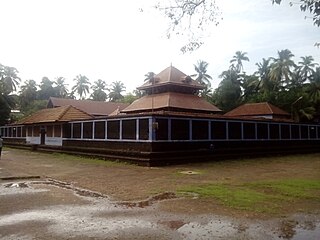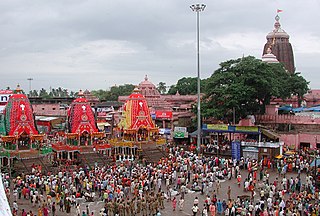This article has multiple issues. Please help improve it or discuss these issues on the talk page . (Learn how and when to remove these template messages)
|

The annual festival of Trichambaram Temple (Trichambaram Utsavam) is a colourful event.
This article has multiple issues. Please help improve it or discuss these issues on the talk page . (Learn how and when to remove these template messages)
|

The annual festival of Trichambaram Temple (Trichambaram Utsavam) is a colourful event.
The fortnight-long festival begins on Kumbham 22 of Malayalam calendar (which generally falls on 6 March) every year with the kodiyettam (hoisting of a religious flag) and comes to an end on Meenam 6 (which generallay falls on 20 March) with Koodipiriyal (Ending of this festival). In between these dates, for 11 days, thitambu nriththam (a sort of dance with the deities of Krishna and Balarama) is held at Pookoth Nada (1 km from Trichambaram temple). On the last day, the devotees run from Trichambram temple to Mazhur temple shouting Govinda!, Govinda!.
A sacred place of the Vaishnava sect that predates the 10th century, the deity of the temple is Sree Krishna. The sculptures on the walls of the sanctum sanctorum are unique by themselves. The annual temple festival, usually held in March, is a colourful event.
The procession on the final day of the festival starts from Taliparamba and proceeds to Mazhur village through the Chinmaya Mission Road. The devotees shout Govinda, Govinda all the way and they carry lighted cloth torches in the procession. This procession is essentially a fast-paced one and all the participants have to run during the ceremony. Even the policemen on duty inside the procession have no other option as the rituals insist a running ceremony.

Mahamaham, also known as Mahamagham or Mamangam, is a Hindu festival celebrated every 12 years in the Mahamaham tank located in the city of Kumbakonam in Tamil Nadu in the south of India. This 20-acre square tank surrounded by Shiva mandapams is believed by Tamil Hindus to be ancient, and the holy confluence of nine Indian river goddesses: Ganga, Yamuna, Sarasvati, Narmada, Godavari, Krishna, Tungabhadra, Kaveri, and Sarayu, states Diana Eck – a professor of Comparative Religion and Indian Studies. On the day of the Mahamaham festival, the river goddesses and Shiva gather here to rejuvenate their waters, according to a legend in the Periya Purana. The Hindus consider taking a pilgrimage and holy dip at the Mahamaham tirtha on the day of Mahamaham festival as sacred. The event attracts chariot processions, street fairs and classical dance performances in temple mandapas. The 12-year cycle Mahamaham festival in Tamil Nadu is observed in the Hindu calendar month of Magha, and is a symbolic equivalent of the Kumbh Mela.

Sri Venkateswara Swami vari Brahmotsavam or Srivari Brahmotsavam is the most significant annual fête celebrated at the Venkateswara Temple in Tirumala-Tirupati, Tirupati district, Andhra Pradesh, India. The feast lasts for one month during the Hindu calendar month of Āśvina, which falls between the Gregorian calendar months of September and October.

Trichambaram Temple is a Krishna temple located in Taliparamba, in Kannur district of Kerala, South India. The main deity of the temple is Krishna after "Kamsavadham" sitting in His "Raudra" posture. The Temple is among the Abhimana Kshethrams which is a list of hoary Vaishnavite shrines.

Koodalmanikyam Temple is a Hindu temple in Irinjalakuda Municipality, Thrissur district, Kerala, India. The temple comprises a main structure, a walled compound with citadels, and four ponds around the main structure one of which is within the walls. Koodalmanikyam Temple is the only ancient temple in India dedicated to the worship of Bharata, of Rama, however the idol is that of god Vishnu. "Sangameshwara" is another name associated with the deity at Koodalmanikyam. The temple is one of four in Kerala that form a set called "nalambalam", each temple dedicated to one of the four brothers in the epic Ramayana: Rama, Bharata, Lakshmana and Shatrughna.

Melukote in Pandavapura taluk of Mandya district, Karnataka, in southern India, is one of the sacred places in Karnataka.It is built on rocky hills, known as Yadugiri, Yaadavagiri or Yadushaila, overlooking the Cauvery valley. Melukote is about 51 km from Mysore and 133 km (83 mi) from Bangalore.

Gunlā is the tenth month in the Nepal Sambat lunar calendar, the national lunar calendar of Nepal. It corresponds to August of the Gregorian Calendar.

The Arulmigu Sri Mahamariamman Temple is a Hindu temple within George Town in the Malaysian state of Penang. The oldest Hindu temple in the state, it was built in 1833, and features sculptures of gods and goddesses over its main entrance and facade.

The Aranmula Parthasarathy Temple is a Hindu temple located near Aranmula, a village in Pathanamthitta District, Kerala, South India. It is dedicated to the Lord Krishna, an avatar of Vishnu, who is worshipped as Parthasarathy. Constructed in the Kerala style of architecture, it is one of the "Divya Desams", the 108 temples of Vishnu revered by the Alvar saints.
This article lists the traditional festivals and other cultural events in the Odisha region of India. Odisha celebrates 13 festivals in 12 months as the saying goes Bāra Māsare Tera Parba.

Gundicha Temple, is a Hindu temple, situated in the temple town of Puri in the state of Odisha, India. It is significant for being the destination of the celebrated annual Rath Yatra of Puri. While it remains vacant most of the year, the temple is occupied by images of the deities of Jagannath, his brother Balabhadra and sister Subhadra for seven complete days every year during the annual Rath Yatra festival.
Bengaluru Karaga is an annual festival celebrated in the Tigalare Pete, primarily by the Vahnikula Kshatriya or Thigala community. Based on story of their heritage, they built temples for Draupadi and Dharmaraya (Yudhishthira). Adishakti Draupadi is the community Deity of the Vahnikula Kshatriyas, one of the foremost communities in Karanataka state. The Dharmaraya Swamy Temple itself is more than 800 years old. It was built by the Vahnikula Kshatriyas, one of the city's oldest communities that was into agriculture and horticulture. The Karaga festival is generally led by the Vahnikula Kshatriyas. Karaga is one of the many traditions of worshiping Adisakti Draupadi Devi. Karaga pooja and festivals have been celebrated in Tamil Nadu and Karnataka since ages. Its practice is in use in some parts of Kolar district and Bangalore in the state of Karnataka. It is learnt that there are forty lakh people belonging to the Vahnikula Kshatriya community living throughout the state: Hoskote, Malur, Kolar, Bengaluru and Anekal taluks have high populations of the Vahnikula Kshatriya community in both urban and rural areas. Basically, this community depends upon agricultural and horticultural activities.

Mandi Shivaratri Fair is an annual renowned international fair that is held for 7 days starting with the Hindu festival of Shivaratri, in the Mandi town of the Indian state of Himachal Pradesh.

Sri Radha Krishna-Chandra Temple is one of the largest Krishna-Hindu temples in the world. It is situated in Bangalore in the Indian state of Karnataka. The temple is dedicated to Hindu deities Radha Krishna and propagates monotheism as mentioned in Chandogya Upanishad.

Mahamaham tank is a huge temple tank located in Kumbakonam, Tamil Nadu, India. It is considered to be the foremost and one of the largest temple tanks in Tamil Nadu. The Masimaham festival held in the tank has 100,000 visitors and the once-in-12-year Mahamaham festival has close to 2 million visitors.

A brahmotsava, also rendered mahotsava and tiruvila is the principal festival of a Hindu temple.

Ratha Yatra, or chariot festival, is any public procession in a chariot. They are held annually during festivals in India, Nepal and Sri Lanka. The term also refers to the popular annual Ratha Yatra of Puri. that involve a public procession with a chariot with deities Jagannath, Balabhadra, Subhadra and Sudarshana Chakra on a ratha, a wooden deula-shaped chariot.

Pachaimalai Arulmigu Subramanya Swamy Temple, also known as the Pachaimalai Balamurugan Temple, is one of the two major hill temples located in Gobichettipalayam, Tamil Nadu, India. The temple is dedicated to the Lord Murugan. The temple is constructed in the Tamil style of architecture and is located on top of a small hillock in the outskirts of the town of Gobichettipalayam near Pudupalayam, Tamil Nadu. Here, Kartikeya is venerated as Balamurugan or Subramanya Swamy.

The Arulmigu Balathandayuthapani Temple, also known as the Waterfall Hilltop Temple, is a Hindu temple within George Town in the Malaysian state of Penang. Dedicated to Lord Murugan, the hilltop temple, with its seven-storey 21.6 m-tall gopuram, has been touted as the largest Lord Murugan temple outside India. It is sited comparatively higher above ground than Batu Caves, with devotees having to climb over 500 steps to access the place of worship.

Jhulan Purnima,Jhulan Yatra or Hindola is a Hindu swinging festival that is dedicated to Hindu god Krishna and goddess Radha. It is popularly celebrated by the Hindu Vaishnava sect in the month of Shravana (July-August) which falls under the monsoon season in India when the weather is hot, humid and slightly breezy. This festival is known for its display of decorated swings, songs and dance. It is a joyful festival which celebrates the amour of divine couple Radha and Krishna along with the romantic fervor of the rainy season in India.